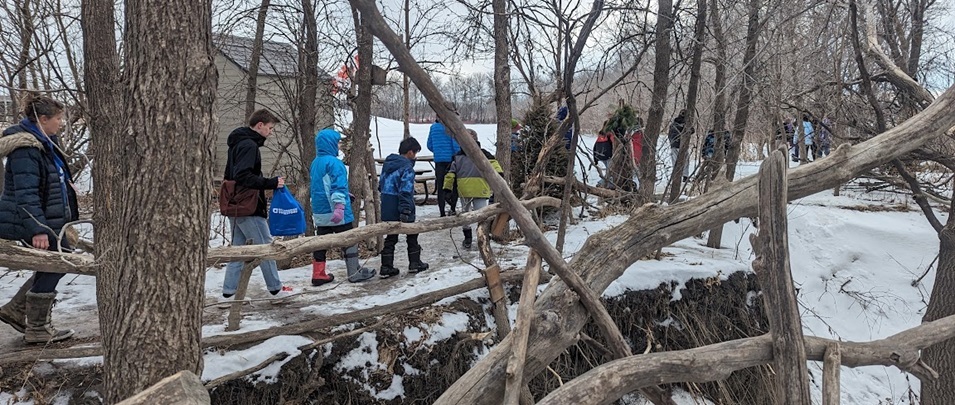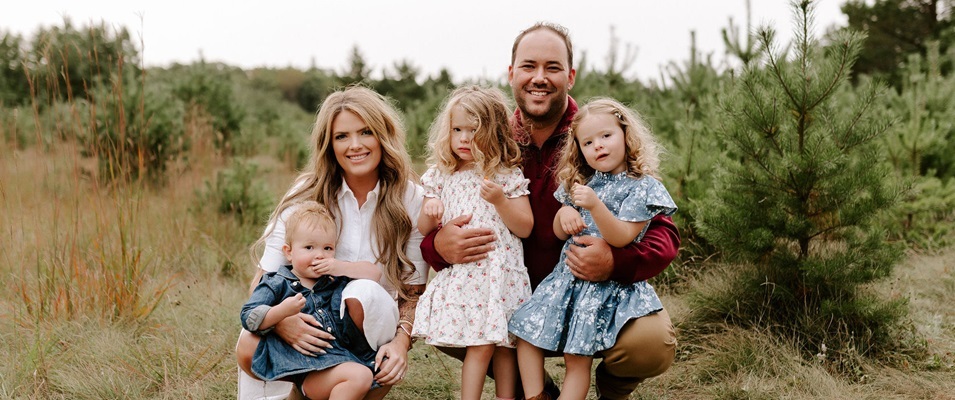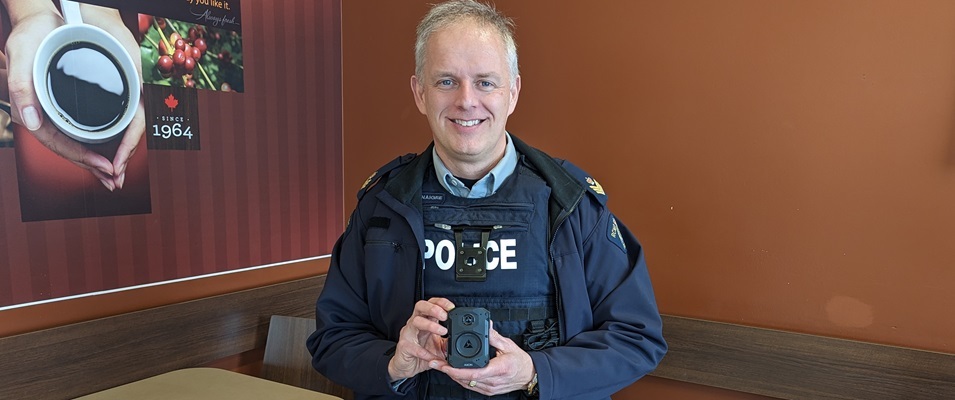
On March 1, a group of Grade Ten students from Niverville High School met up with a group of Niverville Middle School Grade Six students at St. Adolphe’s Friendship Trail to help teach them about natural resources and ecosystems.
The Grade Ten class was working on a Responsibly Resourceful Project, which combines learning outcomes in the areas of geography and science. Students learned about a variety of resources in Canada and many students chose to deepen their learning around forestry issues.
“Some of our big driving questions were, how do human activities impact ecosystems?” says NHS teacher Jennifer Hashemian. “What are issues with how we manage natural resources? How can we sustainably manage resources? What are Indigenous perspectives in regards to natural resources?”
Once students had learned about various natural resource issues, they had to decide how to their power and agency to share their new understanding.
Two students chose to learn about the National Healing Forest Initiative (NHFI), a community-led not-for-profit that has collaborated with the David Suzuki Foundation and Royal Canadian Geographical Society. The students reached out to the NHFI organizers and over the course of an hour-long video conference learned about these healing forests and the importance of forests to ecosystems and human and animal well-being.
“In researching healing forests, we discovered that there was a nearby healing forest in St. Adolphe called the Friendship Trail,” says Hashemian. “Some of the students who studied various aspects of forestry and logging decided to team up to plan a field trip. They decided to invite a middle school class and educate them about the importance of forests as a natural resource and integral part of our ecosystems.”
Hashemian says it was a group of seven students who put in the work and planned the trip together, with the rest of the class agreeing to come to assist.
Trip to a Healing Forest
According to the David Suzuki Foundation, a healing forest provides safe spaces for healing, reconciliation, and community building. The Friendship Trail in St. Adolphe received this designation in 2022 and has held many events onsite to support truth and reconciliation, as well as provide general education about plants and animals, Metis history, and the mental health benefits of being in nature.
Gerry Lagasse is on the Friendship Trail committee and helped facilitate the visit .
“It was an honour to have the Niverville Grade Sixes, with the guidance of the Grade Ten students, along with the two teachers and principal having such an amazing educational outing,” says Lagasse. “There was a great ambience between the teachers and students learning and enjoying the beauty of the forest and nature surrounded by a bonfire pit and hot chocolate.”
Lagasse invites anyone interested in nature to come and enjoy the beautiful trail, which also includes a bird sanctuary, fire pits, picnic tables, and a photo studio.
“[The trail] is open year-round, although some of the best times are May and June for school outings. Every group or individuals are welcome and no bookings are required.”
The Friendship Trail committee supported the field trip by organizing volunteers to set up the fire pits. NHS supplied everyone with snacks and hot chocolate at the end.
For Hashemian, it was rewarding to see her students exercise their leadership skills.
“The seven organizers did everything to plan the trip with my guidance,” says Hashemian. “They spoke to Ms. Kimberley [NHS principal] for permission and contacted teachers at the middle school to find a class to partner with. They planned their lessons and got feedback from me on how to improve. The seven organizers, with Ms. Kimberley and I, went to the forest a week prior to the trip to see the space and plan out the details.”
After identifying the learning goals for the trip, the young team decided they would make various stops along the trail to deliver their part of the lesson.
Hashemian says that the older students wanted to give the younger students an important experience to learn about how valuable our forests are. At the trail site, the students organized themselves, pairing up two Grade Six students with each Grade Ten student.
“It is important to introduce something valuable to young minds because they can start thinking about these important issues,” says one of the student leaders. “Making the activities fun can really capture their attention and would make them want to learn about the topic.”
Another older student says that their goal was to cover the main phases of a forest’s life, as well as the effects of deforestation, using trivia questions from their in-class lessons to keep the attention of the younger students and make it fun.
“The trivia questions went really well,” they say. “The kids all answered them correctly, which means the lesson went well… We also got them to decorate and write one fact that they learned on a wooden ornament to hang up in the forest.”
Interpersonal Connections
The day trip provided a lot of opportunities for cementing the learning done in the classroom, and left students with the bonus of having made new friendships and connections.
“We had absolutely beautiful weather and the connections and learning that happened that day were heart-warming,” said Hashemian. “The Grade Sixes were very engaged and asked lots of questions. The connections I saw between the Tens and Sixes were amazing. It was so wonderful to see these teens be caring and tender towards the younger students.”
Building connections with younger students was a new experience for a lot of the Grade Ten participants and helped them utilize interpersonal skills they may not have had a lot of opportunity to use before.


















